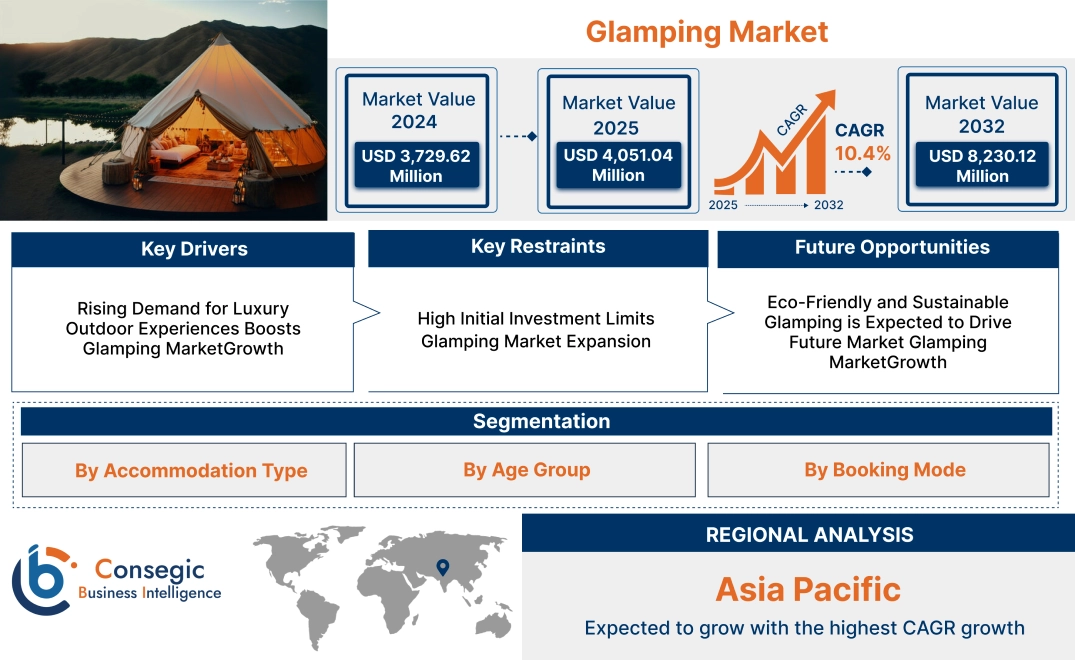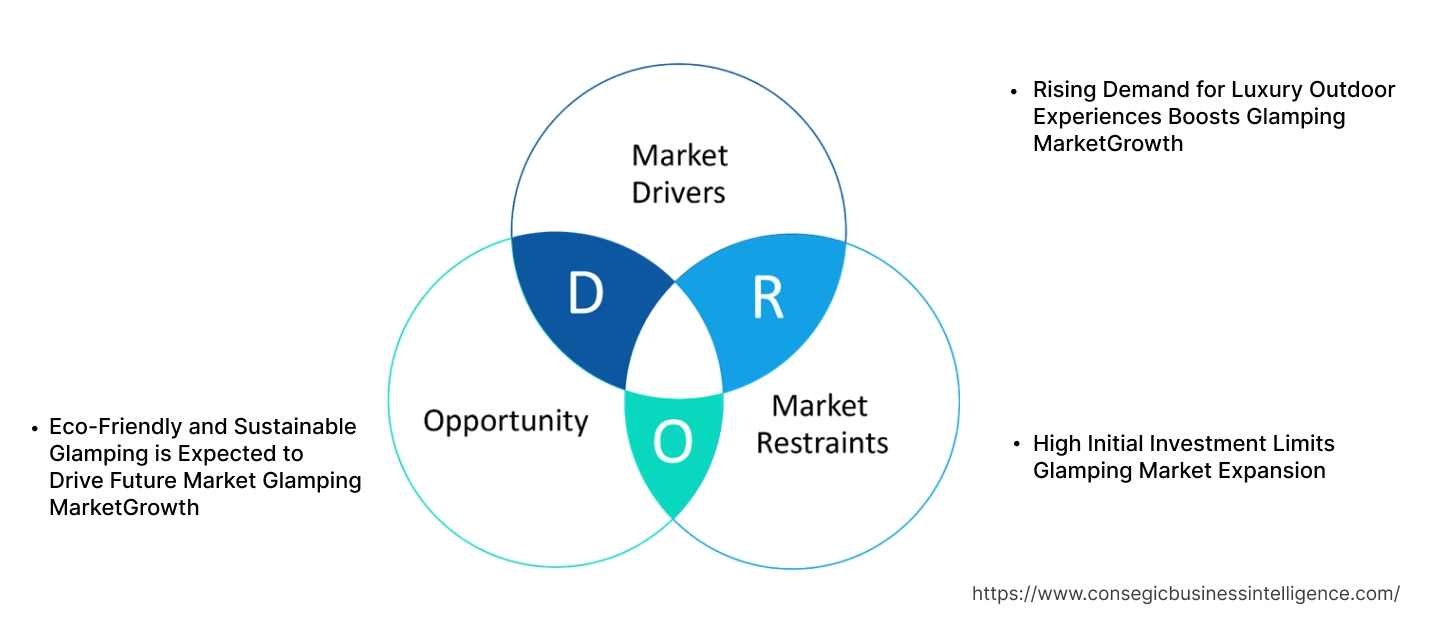- Summary
- Table Of Content
- Methodology
Glamping Market Size:
Glamping Market size is estimated to reach over USD 8,230.12 Million by 2032 from a value of USD 3,729.62 Million in 2024 and is projected to grow by USD 4,051.04 Million in 2025, growing at a CAGR of 10.4% from 2025 to 2032.
Glamping Market Scope & Overview:
Glamping, or glamorous camping, offers a luxury outdoor experience with modern amenities, providing an alternative to traditional camping. It combines nature with high-end accommodations, ensuring comfort without sacrificing outdoor adventure. Glamping accommodations include yurts, cabins, safari tents, and treehouses equipped with electricity, private bathrooms, and premium furnishings.
The benefits of glamping include enhanced comfort, unique experiences, and eco-friendly lodging. It provides access to nature without the need for extensive camping gear. Glamping sites incorporate sustainable practices, including solar energy and eco-conscious materials, supporting responsible tourism.
Glamping is widely adopted in hospitality, tourism, and travel industries. It caters to adventure seekers, eco-tourists, and luxury travelers looking for personalized outdoor experiences. Popular applications include wellness retreats, family vacations, and corporate getaways, offering a balance of relaxation and outdoor exploration.
Key Drivers:
Rising Demand for Luxury Outdoor Experiences Boosts Glamping Market Growth
Luxury outdoor accommodations offer travelers a unique blend of nature and comfort, making them a popular alternative to traditional camping. Glamping provides upscale amenities such as king-sized beds, gourmet dining, and private bathrooms, enhancing the outdoor experience while maintaining convenience. This trend is particularly gaining traction among urban consumers seeking immersive yet comfortable travel experiences. For instance, high-end glamping sites now feature personalized concierge services, spa facilities, and curated adventure packages. Therefore, the increasing glamping market demand for luxurious yet nature-integrated accommodations is fueling the glamping market expansion of glamping.
Key Restraints:
High Initial Investment Limits Glamping Market Expansion
Establishing a glamping site requires a significant initial investment in infrastructure, luxury amenities, and land acquisition. Unlike traditional camping setups, glamping accommodations include high-end tents, cabins, domes, or treehouses, which demand durable materials and sophisticated interior designs. Additionally, the maintenance costs of these premium accommodations add to the financial burden. Small and medium-sized businesses face challenges in securing funding for such capital-intensive projects, limiting their entry into the market. These financial barriers restrict the widespread adoption of glamping accommodations, hindering the overall market expansion.
Future Opportunities :
Eco-Friendly and Sustainable Glamping is Expected to Drive Future Market Glamping Market Growth
Sustainability trends are influencing consumer preferences, leading to a rise in glamping market demand for eco-friendly glamping options. Future glamping sites will incorporate renewable energy sources, eco-conscious building materials, and waste reduction initiatives. Many companies are already investing in solar-powered cabins, rainwater harvesting systems, and biodegradable amenities to cater to environmentally conscious travelers. For example, several luxury glamping resorts are designing carbon-neutral accommodations to align with global sustainability goals. Thus, the emergence of sustainable glamping solutions is expected to create significant glamping market opportunities in the coming years.
Glamping Market Segmental Analysis :
By Accommodation Type:
Based on accommodation type, the glamping market is segmented into cabins and pods, tents, yurts, treehouses, tipis, and others.
The cabins and pods sector accounted for the largest revenue in glamping market share in 2024.
- Cabins and pods offer a balance of comfort and outdoor experience, attracting travelers seeking high-end amenities in a natural setting.
- These structures provide insulation, climate control, and enhanced security, making them a preferred choice for families and luxury travelers.
- The integration of sustainable materials and smart technologies in cabin designs further enhances their appeal.
- Additionally, the growing popularity of eco-tourism and growth for private retreats have significantly contributed to the revenue growth of this segment.
- Therefore, according to glamping market analysis, these trends highlight the increasing consumer preference for well-equipped and comfortable glamping accommodations.
The treehouses sector is anticipated to register the fastest CAGR during the forecast period.
- Treehouses offer a unique, immersive experience that aligns with the growing consumer interest in adventure and nature-centric vacations.
- Many treehouse accommodations incorporate eco-friendly materials and off-grid living features, attracting environmentally conscious travelers.
- Social media influence and rising interest in novel lodging options have further contributed to the popularity of treehouses.
- The increasing number of boutique resorts offering treehouse accommodations has expanded the accessibility of this segment.
- Thus, according to glamping market analysis, these factors collectively contribute to the anticipated growth of the treehouses segment.
By Age Group:
Based on age group, the glamping market is segmented into 18–32 years, 33–50 years, 51–65 years, and above 65 years.
The 33–50 years segment accounted for the largest revenue in glamping market share by 35.43% in 2024.
- Individuals within this age group prioritize premium travel experiences that combine luxury and nature, making glamping an attractive option.
- They have higher disposable incomes and are more likely to spend on experiential travel and eco-friendly accommodations.
- Families within this age bracket also prefer glamping due to the convenience and security offered by structured accommodations.
- Many glamping destinations offer family-friendly amenities, such as guided nature tours and outdoor activities, further increasing glamping market trend.
- Therefore, according to the market analysis, these trends emphasize the strong market position of the 33–50 years age group in the glamping industry.
The 18–32 years segment is anticipated to register the fastest CAGR during the forecast period.
- Younger travelers are increasingly opting for unique and Instagram-worthy travel experiences, driving interest in glamping.
- Budget-friendly yet high-quality glamping options, including tents and yurts, appeal to this demographic.
- Digital booking platforms and social media marketing have enhanced visibility and accessibility for young travelers.
- The emphasis on eco-tourism and adventure tourism among millennials and Gen Z further fuels growth in this segment.
- Thus, according to the market analysis, these factors collectively contribute to the rising glamping market trend within the 18–32 years age group.
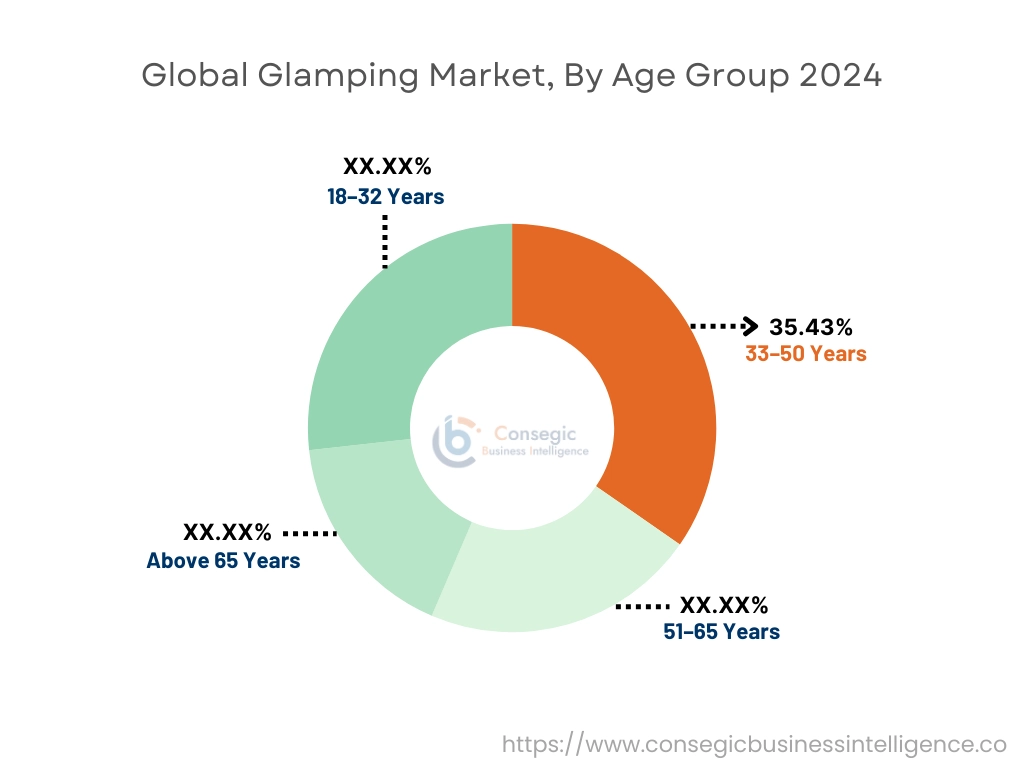
By Booking Mode:
Based on booking mode, the glamping market is segmented into online and offline.
The online booking mode accounted for the largest revenue share in 2024 and is anticipated to register the fastest CAGR during the forecast period.
- The increasing penetration of digital travel platforms has made online booking the most preferred mode for glamping reservations.
- Travelers rely on online platforms for comparing accommodations, checking reviews, and accessing exclusive deals.
- The rise of mobile applications and AI-driven personalization in travel services further enhances the user experience.
- Online platforms also offer flexible booking options, real-time availability, and instant confirmation, making them highly convenient.
- The growing adoption of online travel agencies (OTAs) and direct booking websites has strengthened the dominance of online booking in the market.
- Therefore, according to the market analysis, the factors collectively contribute to the strong revenue share and expected growth of online booking in the glamping industry.
Regional Analysis:
The regional segment includes North America, Europe, Asia Pacific, Middle East and Africa, and Latin America.
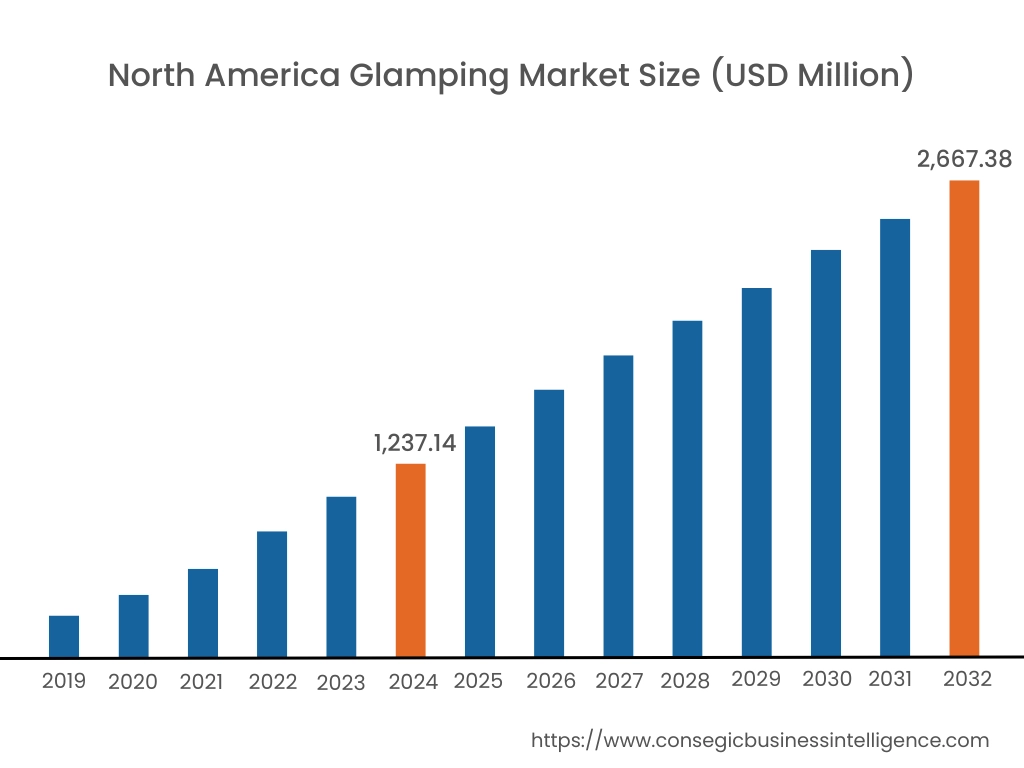
In 2024, North America was valued at USD 1,237.14 Million and is expected to reach USD 2,667.38 Million in 2032. In North America, the U.S. accounted for the highest share of 75.95% during the base year of 2024.
North America holds a significant share of the glamping market due to the increasing preference for outdoor recreational activities. The United States and Canada are key contributors, with rising consumer spending on unique travel experiences. The presence of luxury glamping resorts and eco-friendly accommodations enhances market expansion. Advanced tourism infrastructure, coupled with a strong emphasis on sustainability, supports the adoption of premium camping facilities.
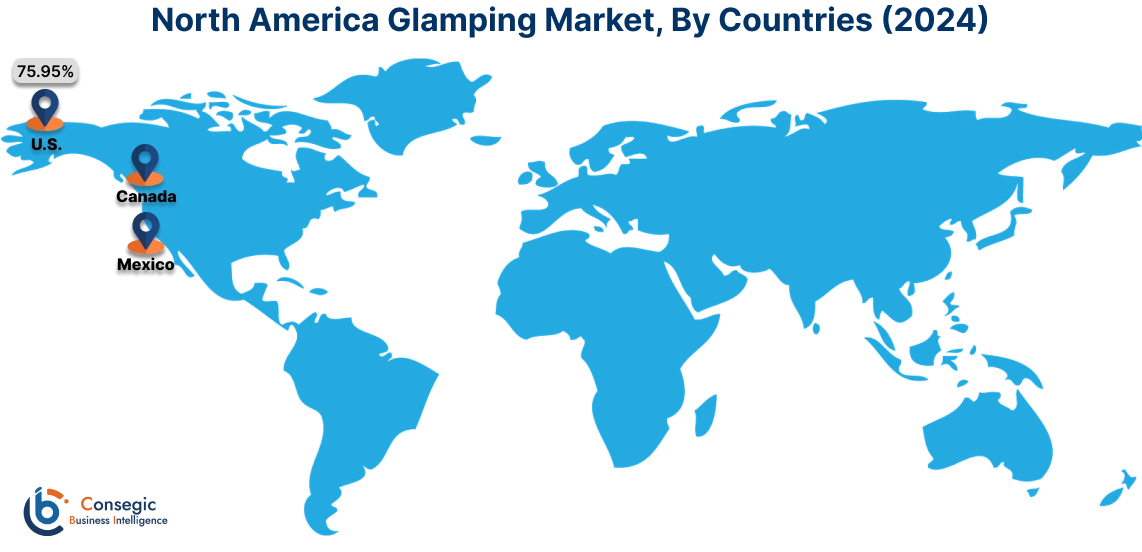
In Asia Pacific, the market is experiencing the fastest growth with a CAGR of 10.9% over the forecast period.
Asia-Pacific is witnessing substantial trend for glamping due to changing travel preferences in countries like China, Japan, Australia, and India. The region’s expanding middle-class population and increasing interest in adventure tourism contribute to the market. Governments are promoting eco-tourism, leading to investments in luxury camping facilities. The growing popularity of digital nomadism also encourages interest in unique outdoor accommodations.
Europe remains a key region in the glamping market due to the high demand for experiential travel. Countries such as the United Kingdom, France, Italy, and Germany have a well-established luxury camping industry. The presence of heritage sites, national parks, and scenic landscapes enhances the market’s appeal. Rising consumer interest in eco-friendly tourism and sustainable accommodations supports market development.
The Middle East and Africa are experiencing rising trend for glamping, particularly in the UAE and South Africa. Luxury desert camps and safari lodges are attracting high-end travelers. The region’s focus on promoting tourism through unique hospitality offerings strengthens market performance. Investments in eco-resorts and adventure tourism further contribute to the adoption of glamping accommodations.
Latin America is emerging as an attractive destination for glamping, driven by tourism in countries like Brazil, Mexico, Argentina, and Costa Rica. The region’s natural landscapes, including rainforests and coastal areas, provide opportunities for luxury camping experiences. Governments are supporting sustainable tourism initiatives, encouraging investments in eco-lodges and glamping resorts. Adventure tourism’s increasing popularity also supports the market’s expansion.
Top Key Players and Market Share Insights:
The global glamping market is highly competitive with major players providing products and services to the national and international markets. Key players are adopting several strategies in research and development (R&D), product innovation, and end-user launches to hold a strong position in the global glamping market. Key players in the glamping industry include-
- AutoCamp – North America (United States)
- Under Canvas – North America (United States)
- Clayoquot Wilderness Lodge – North America (Canada)
- Longitude 131° – Australia (Australia)
- The Resort at Paws Up – North America (United States)
- Collective Retreats – North America (United States)
- Huttopia – Europe (France)
- Glamping Hub – Europe (Spain)
- Canopy & Stars – Europe (United Kingdom)
- Nightfall Camp – Australia (Australia)
Recent Industry Developments :
Product launches:
- In January 2025, Pebble, a California-based company, is set to release the Pebble Flow, an electric RV travel trailer designed to enhance the glamping experience with eco-friendly features. Equipped with a 45-kWh lithium-ion battery, it can power amenities for up to seven days. The trailer boasts a sleek design and luxurious interiors, including a kitchen, bathroom, and convertible dining and sleeping areas. Features are controllable via a mobile app, with production and delivery anticipated in the first half of 2025.
- In November 20204, Nick and Kate Boshammer have launched Riverbank Glamping along the Condamine River near Chinchilla. The site features a safari-style tent equipped with a king-size bed, kitchen, ensuite, air conditioning, coffee machine, movie projector, open fireplace, and outdoor bathtub. This venture aims to provide a luxurious outdoor experience, contributing to local tourism.
- In 2024, Iglucraft celebrated its 10th anniversary by launching a new sauna model, with David Beckham as the first owner. The sauna features a distinctive design, combining traditional craftsmanship with modern aesthetics, catering to luxury glamping enthusiasts.
Partnerships & Collaborations:
- In December 2024, West Beach Parks, a prominent holiday destination in South Australia, entered into a partnership with Discovery Parks. This collaboration led to the rebranding of the site as "Discovery Parks - West Beach Parks." The agreement grants Discovery Parks branding rights and access to over 750,000 annual bookings through their network. West Beach Parks retains ownership and management, while benefiting from Discovery Parks' extensive reach. This partnership aims to enhance the visitor experience and capitalize on the growing tourism sector in the region.
Mergers and Acquisitions:
- In February 2025, Australian travel company Intrepid acquired Dutch tour operator Sawadee Reizen, enhancing its presence in the European travel market. This acquisition is expected to increase Intrepid's annual turnover by $100 million and add 20,000 customers annually. Sawadee will continue to operate under its existing brand and management in Amsterdam.
Glamping Market Report Insights :
| Report Attributes | Report Details |
| Study Timeline | 2019-2032 |
| Market Size in 2032 | USD 8,230.12 Million |
| CAGR (2025-2032) | 10.4% |
| By Accommodation Type |
|
| By Age Group |
|
| By Booking Mode |
|
| By Region |
|
| Key Players |
|
| North America | U.S. Canada Mexico |
| Europe | U.K. Germany France Spain Italy Russia Benelux Rest of Europe |
| APAC | China South Korea Japan India Australia ASEAN Rest of Asia-Pacific |
| Middle East and Africa | GCC Turkey South Africa Rest of MEA |
| LATAM | Brazil Argentina Chile Rest of LATAM |
| Report Coverage |
|
Key Questions Answered in the Report
How big is the Glamping Market? +
In 2024, the Glamping Market was USD 3,729.62 million.
What will be the potential market valuation for the Glamping Market by 2032? +
In 2032, the market size of Glamping Market is expected to reach USD 8,230.12 million.
What are the segments covered in the Glamping Market report? +
The accommodation type, age group, and booking mode are the segments covered in this report.
Who are the major players in the Glamping Market? +
AutoCamp – North America (United States), Under Canvas – North America (United States), Collective Retreats – North America (United States), Huttopia – Europe (France), Glamping Hub – Europe (Spain), Canopy & Stars – Europe (United Kingdom), Nightfall Camp – Australia (Australia), Clayoquot Wilderness Lodge – North America (Canada), Longitude 131° – Australia (Australia), The Resort at Paws Up – North America (United States) are the major players in the Glamping market.
